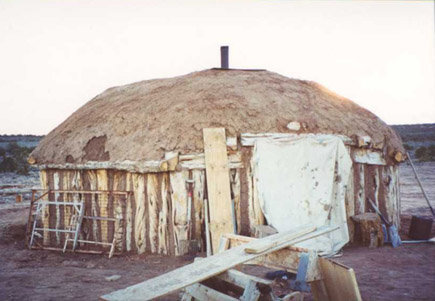 An expanded version of my Indian Comics Irregular essay SKINWALKER Defies Taboos:
An expanded version of my Indian Comics Irregular essay SKINWALKER Defies Taboos: An expanded version of my Indian Comics Irregular essay SKINWALKER Defies Taboos:
An expanded version of my Indian Comics Irregular essay SKINWALKER Defies Taboos:
[SPOILER ALERT! Stop here if you haven't read the comic and plan to.]
Oni Press has published a four-issue comic-book series called SKINWALKER. In it, a white FBI agent goes rogue on the Navajo reservation. He learns the forbidden practice of skinwalking and duplicates it by artificial means (drugs, acupuncture). Killing people, he dons their skins and becomes them. Each new skin lasts only a while, so he must keep killing to stay alive.
The first issue offers a fine depiction of the Navajo reservation—one of the best I've seen in comics. Except for the clichéd opening shot of Monument Valley, the rendition of the landscape is appropriately nondescript—no buttes or cacti in the background. A smattering of Navajo words, concepts, and place names gives the story a genuine feel.
The characters, especially Ann Adakai, the Navajo policewoman, seem three-dimensional. In one scene, officer Adakai disagrees with a "peacemaking" ceremony used to resolve a juvenile delinquent's crime. In another, the delinquent's mother if whether Adakai is really Diné (Navajo). Adakai's relationship with visiting FBI agent ("feeb") Haworth is also realistically charged.
Issue #1 ends with the police finding a skinned body in a hogan. The story says little or nothing about Navajo beliefs once the cops determine the killer is a skinwalker. There are no phony ceremonies or mystical mumbo-jumbo.
The villain flees the rez and goes on a cross-country killing spree. The story turns into a typical cat-and-mouse game between the heroes and a Jack the Ripper-style chameleon who could be anyone. The ending is anti-climactic.
Are taboos broken?
The Navajo have a strong taboo against death and dead bodies. The gruesome closeup of the skinned body arguably violates this taboo. Does SKINWALKER show an authentic response to this?
As Tony Hillerman wrote about a similar situation in his book The First Eagle, "It would require at least a sweat bath and, more properly, a curing ceremony to restore the violators of such taboos to hozho." Nothing like that happens in the comics.
Perhaps more important, the whole subject of skinwalkers is off-limits to many Navajos. But SKINWALKER has an Anglo, not a Diné, becoming a skinwalker by artificial, not natural, means. That confounds the question.
I asked my correspondents what they thought of this gimmick. Some replies:
Your guess is a good as mine what a Navajo would object to, but I sure wouldn't want my people held up in that light if I could avoid it. It's also kind of preposterous...like learning shapeshifting during summer camp.

Steve Russell (Cherokee)
I am conjecturing on this. I don't see a problem since it is so fictionalized.
The problems/taboos come up with real bodies.
Jason Spaulding
I'd say the older folks probably won't pay it much attention while the younger folks, well, some will be interested in it while the one-drop cyber-one-day-wonders will crucify you.
PumaClaw (Navajo)
At least one Dineh woman I know (who is in her early 20s, mixed-blood, grew up off rez, and doesn't speak much Dineh) found Tony Hillerman's books to be offensive, so I'm sure she would find these comic books even more so.
What she objected to was the reworking of traditional lore and beliefs to suit the ends of a commercial product and a Western (as in Western Civ) style of literary narrative.
I won't speak to whether this is an accurate picture of skinwalkers since I'm not Navajo. But if this is an inaccurate picture, I recall something a little bit similar that might suggest something.
Some Navajo I've spoken to weren't especially offended by a New Age knock-off of the Blessing Way. Basically, what some New Agers are doing is selling how-to video tapes. But their version of the Blessing Way reduces it to almost like a baby shower.
These Dineh explained to me that their belief says an inaccurate version or depiction of a ceremony can do no harm. It's simply useless. And the inherent sacredness of a ceremony like Blessing Way is strong enough to withstand any distorted versions.
So maybe they'd think:
1) No harm done even if the story is inaccurate, but
2) There is harm done by twisting Navajo lore for commercial purposes and a different style of narrative.
Al Carroll (Mescalero Apache)
All the Navajos I know don't even mention the word "skinwalker"....Given that, what more can I say?
Lorri Carrico (EastMain/Free Cree)

There you have it. The answer is a definite maybe.
The series' worst problem may be its washed-out printing and microscopic lettering. These make the comics difficult to read. That's too bad, since the gray-toned black-and-white art is otherwise effective.
If you're interested in Native-themed comic books, give SKINWALKER a look.
The problem with depicting taboos
Playing with taboos is fraught with moral jeopardy. So is rationalizing it.
You could depict a criminal violating any Native taboo—impersonating a kachina (as in Marvel's NFL SUPERPRO #6), casing a kiva's interior (as in a problematical Widget cartoon), or participating in a Sun Dance—then excuse the depiction. "The character should've known what he did was wrong, but he's a criminal, so what can you expect? Yes, we showed him violating the taboo, but we said the criminal was wrong, so we did our duty. We acted responsibly."
No, not really. That the characters and the comic take a stance against the behavior doesn't excuse the creators for portraying that behavior. You can depict any transgression—murder, rape, etc.—in such detail that the question becomes whether you're condemning it or exploiting it. Most media outlets refused to show the Daniel Pearl decapitation video for precisely that reason.
Readers of SKINWALKER can decide for themselves whether the series violates any taboos.
Related links
Skinwalkers: Leaphorn and Chee do public TV
Comic books featuring Indians
|
. . . |

|
All material © copyright its original owners, except where noted.
Original text and pictures © copyright 2007 by Robert Schmidt.
Copyrighted material is posted under the Fair Use provision of the Copyright Act,
which allows copying for nonprofit educational uses including criticism and commentary.
Comments sent to the publisher become the property of Blue Corn Comics
and may be used in other postings without permission.